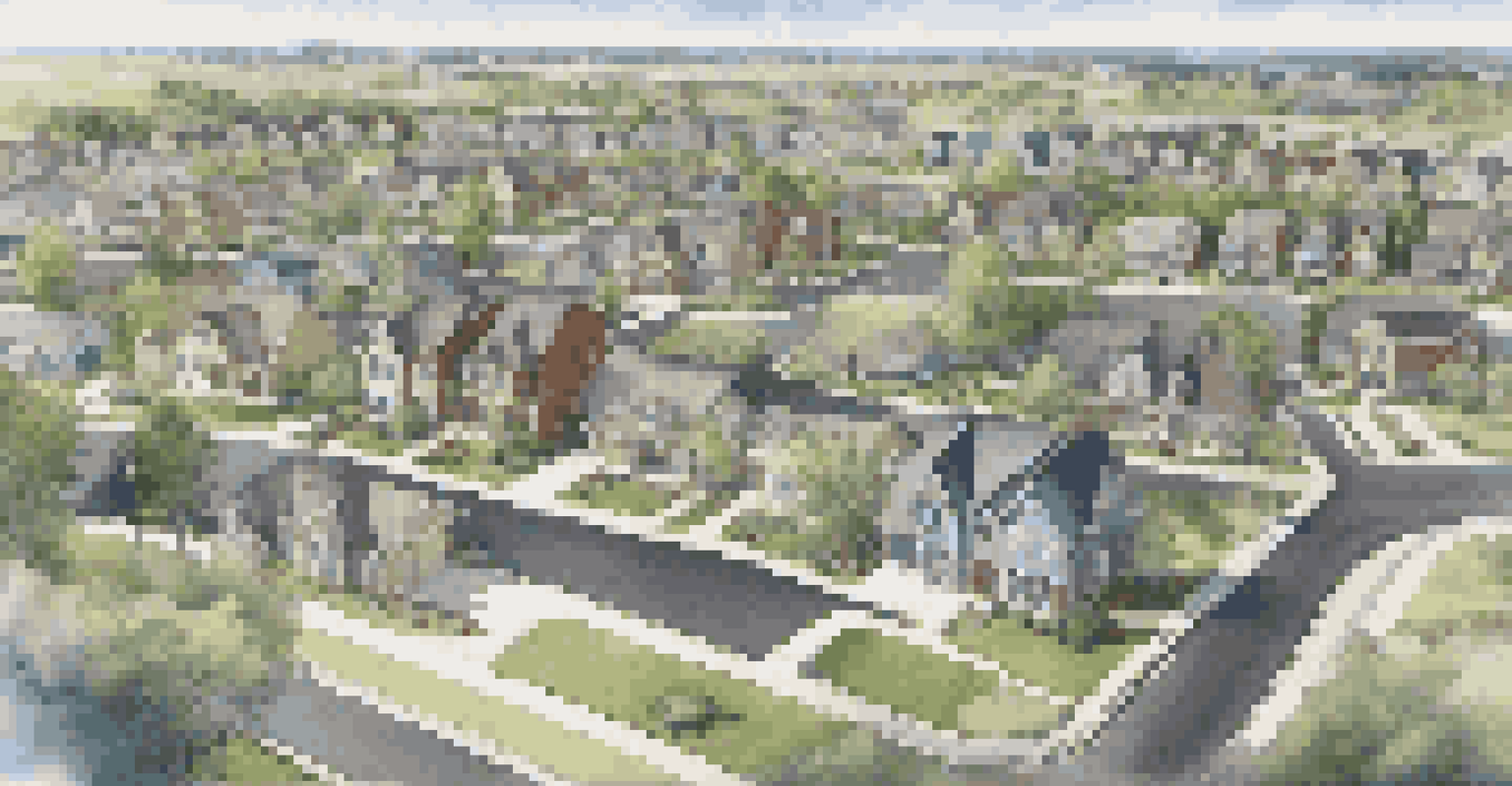The Influence of Local Real Estate Trends on Property Values

Understanding Local Real Estate Trends and Their Importance
Local real estate trends refer to the patterns and changes happening in a specific area’s property market. These trends are influenced by various factors, including economic conditions, demographic shifts, and even cultural movements. Recognizing these trends is crucial for buyers, sellers, and investors who want to make informed decisions.
Real estate is an impermanent asset in a permanent location.
For example, if a neighborhood experiences an influx of young professionals, this could indicate a rising demand for housing, driving up property values. Conversely, if a major employer leaves the area, it might lead to a decline in property values as demand wanes. Understanding these dynamics helps stakeholders anticipate market movements.
Moreover, local trends can vary significantly from one area to another, making it essential to stay informed about your specific market. This localized focus allows you to spot opportunities and risks that could impact your real estate investments.
Economic Factors Influencing Property Values
Economic factors are among the most significant influences on property values. When the economy is strong, job growth tends to increase demand for housing, which can drive property prices up. Conversely, during economic downturns, job losses can result in lower demand and declining property values.

For instance, areas with booming industries often see a surge in property values as people flock to those regions for work. On the other hand, if a downturn hits, such as during a recession, you might see an oversupply of homes and a drop in prices. Understanding these economic cycles can guide buyers and sellers in making strategic decisions.
Local Trends Shape Real Estate Decisions
Understanding local real estate trends helps buyers, sellers, and investors make informed choices in a fluctuating market.
Additionally, interest rates play a crucial role in property values. Lower interest rates often make mortgages more affordable, encouraging buyers to purchase homes, which can further drive up property prices. Keeping an eye on these economic indicators can give you an edge in the property market.
Demographics and Their Role in Real Estate Trends
Demographic shifts can dramatically impact local real estate trends and property values. For instance, an aging population may increase demand for single-level homes or retirement communities, while younger generations might seek urban living options. Understanding these demographic changes helps identify which property types will be in demand.
The best investment on Earth is earth.
Consider how millennials are increasingly moving toward urban areas for job opportunities and lifestyle preferences. This trend has led to rising property values in cities that cater to their needs, such as walkable neighborhoods with access to public transportation. Recognizing these patterns can help investors target the right properties.
Furthermore, shifts in family structures, such as an increase in single-person households, can influence the types of homes that are in demand. By staying attuned to demographic trends, you can make better investment decisions that align with the evolving needs of the community.
The Impact of Infrastructure Development on Property Values
Infrastructure development, such as new roads, schools, and public transportation, can significantly enhance property values in a region. When a new highway or transit line is introduced, for example, it often makes previously less accessible areas more desirable. This increased accessibility can lead to a surge in home prices.
Take the example of a new light rail system being built in a suburban area. As residents anticipate the benefits of easy commutes, demand for homes near the stations can spike. This increase in demand typically leads to higher property values, making it a prime area for investment.
Economic Factors Drive Property Values
Economic conditions, such as job growth and interest rates, significantly influence housing demand and property prices.
Additionally, community amenities like parks, shopping centers, and recreational facilities can also boost local real estate values. As neighborhoods become more attractive, the demand for properties increases, positively impacting their market value.
Market Trends: Seller's vs. Buyer's Market
Understanding whether you are in a seller's or buyer's market is crucial for making informed real estate decisions. In a seller's market, demand exceeds supply, leading to increased prices and competition among buyers. Conversely, in a buyer's market, there are more homes available than buyers, often resulting in lower prices and more negotiating power for buyers.
For example, in a seller's market, you might find homes selling above the asking price due to bidding wars. This can create a sense of urgency for buyers to act quickly, often leading to hasty decisions. Knowing whether the market favors sellers or buyers can help you strategize your approach effectively.
By keeping an eye on inventory levels and days on market statistics, you can gauge the current market conditions. This insight allows you to adjust your buying or selling strategy accordingly, maximizing your chances of a successful transaction.
The Role of Local Government Policies on Property Values
Local government policies can have a profound impact on real estate trends and property values. Zoning laws, property taxes, and development regulations can either encourage or hinder growth in a particular area. For instance, if a city decides to rezone an area for mixed-use development, it can lead to increased property values as new businesses and residents move in.
Additionally, tax incentives for homebuyers or developers can stimulate demand, subsequently raising property values. Conversely, high property taxes may deter potential buyers, leading to stagnation or decline in property values. Understanding these policies is essential for anyone looking to navigate the property market effectively.
Demographics Impact Housing Demand
Shifts in demographics, like aging populations and urban migration, affect the types of homes that are in demand.
Moreover, community initiatives aimed at improving public safety or enhancing local amenities can also contribute to rising property values. Keeping abreast of local government actions can provide valuable insights into future trends and investment opportunities.
The Influence of Technology and Market Data on Real Estate
In today's digital age, technology and data analytics play pivotal roles in shaping real estate trends and property values. Access to real-time market data allows buyers and sellers to make informed decisions based on current conditions. This wealth of information can include everything from neighborhood price trends to economic forecasts.
For example, online platforms enable users to analyze historical property values, helping them determine whether a property is priced fairly. Additionally, machine learning algorithms can predict future price trends based on various factors, offering a competitive edge to savvy investors.

Furthermore, technology has changed how properties are marketed and sold. Virtual tours and online listings allow potential buyers to explore homes from anywhere, broadening the market and increasing competition. Understanding these technological advancements can help you navigate the real estate landscape more effectively.